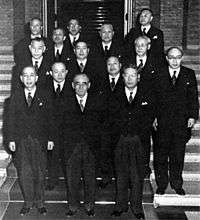Tanzan Ishibashi
| Tanzan Ishibashi | |
|---|---|
| 石橋 湛山 | |
|
Ishibashi in December 1958 | |
| Prime Minister of Japan | |
|
In office 23 December 1956 – 31 January 1957 | |
| Monarch | Shōwa |
| Preceded by | Ichirō Hatoyama |
| Succeeded by | Nobusuke Kishi |
| Personal details | |
| Born |
25 September 1884 Tokyo, Japan |
| Died |
25 April 1973 (aged 88) Osaka, Japan |
| Political party | Liberal Democratic Party (1955–1973) |
| Other political affiliations | Socialist Party (1945–1955) |
| Alma mater | Waseda University |
| Religion | Nichiren-shū, possibly Christian (describing himself as a 'second generation' disciple of William Clark's 'Sapporo Band' and citing the Bible in many of his works[1] |
| Signature |
 |
Tanzan Ishibashi (石橋 湛山 Ishibashi Tanzan, 25 September 1884 – 25 April 1973) was a Japanese journalist and politician. Being a member of Nichiren-shū, the name Tanzan is a religious name, as his profane name was Seizō (省三). He was the 55th Prime Minister of Japan from 23 December 1956 to 25 February 1957. During the same time he was the 2nd president of the Liberal Democratic Party, the majority party in the Diet. From 1952 to 1968 he was also the president of Rissho University.
Life
He was born in Tokyo and graduated from Waseda University. He worked as a journalist at the Mainichi Shimbun for a while. After he finished military service, he joined "Toyo Keizai Shimpo" (Eastern Economic Journal) and later he became its president in 1941. He wrote about Japanese financial policy and had arguments with Inoue Junnosuke. Ishibashi had a liberal political view and espoused the Small Japan policy; the core opinion of his Small Japan policy was the abandonment of Manchuria.

After World War II he received some political offers. The Japan Socialist Party offered to make him a candidate. Ishibashi became the minister of Finance under the first cabinet of Shigeru Yoshida from 1946 to 1947. In 1947 he was purged and therefore retired as both a politician and a journalist. After his purge was repealed in 1951, he allied with Ichirō Hatoyama and joined the movement against Yoshida's cabinet. In 1953 Ishibashi was appointed to minister of Industry by Hatoyama who became the prime minister. In 1955 the Liberal Democratic Party was formed and Ishibashi joined it.
When Hatoyama decided to retire in 1956, the LDP held a vote for their new president. At first Nobusuke Kishi was considered the most likely candidate, but Ishibashi allied himself with another candidate (Kojiro Ishii) and managed to win the election. Ishibashi was appointed as president of the LDP and became the prime minister of Japan. Ishibashi stated that the government should endeavor to set up diplomatic relations with the People's Republic of China and his policy was popular among the people. Unfortunately he became sick and gave up his office only two months later.
After he resigned the post of prime minister and post of president of LDP, he visited China in 1956. He was known as a prominent figure among liberal politicians in the LDP. He opposed Kishi's politics on security, which seemed too militant to Ishibashi.
Honours
From the corresponding article in the Japanese Wikipedia
- Grand Cordon of the Order of the Rising Sun (29 April 1964)
- Grand Cordon of the Order of the Rising Sun with Paulownia Flowers (25 April 1973; posthumous)
| Wikimedia Commons has media related to Tanzan Ishibashi. |
-
| Political offices | ||
|---|---|---|
| Preceded by Ichirō Hatoyama |
Prime Minister of Japan 1956–1957 |
Succeeded by Nobusuke Kishi |
| Preceded by Kiichi Aichi |
Minister of International Trade and Industry 1954-1956 |
Succeeded by Mikio Mizuta |
| Preceded by Keizo Shibusawa |
Minister of Finance 1946-1947 |
Succeeded by Tetsu Katayama Interim |
